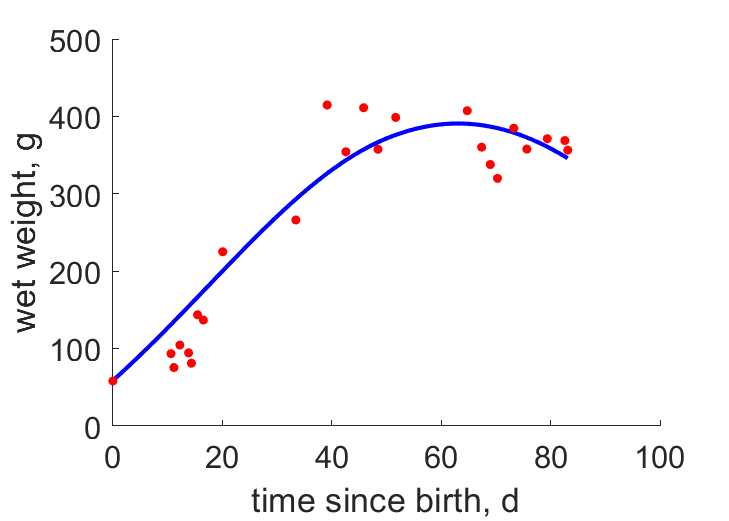Predictions & Data for this entry
| Model: std | climate: MA | migrate: | phylum: |
| COMPLETE = 2.5 | ecozone: MP | food: biCvf, biCik, biCic | class: |
| MRE = 0.040 | habitat: 0iMc | gender: Dg | order: |
| SMSE = 0.005 | embryo: Tntfm | reprod: O | family: |
Zero-variate data
| Data | Observed | Predicted | (RE) | Unit | Description | Reference |
|---|---|---|---|---|---|---|
| ab | 50 | 49.27 | (0.01452) | d | age at birth | arkive |
| tx | 83 | 83.03 | (0.0004062) | d | time since birth at fledging | Brook1995 |
| tp | 249 | 259.2 | (0.04095) | d | time since birth at puberty | guess |
| tR | 730 | 730 | ( 0) | d | time since birth at 1st brood | guess |
| am | 9125 | 9383 | (0.02832) | d | life span | guess |
| Wwb | 58 | 58.38 | (0.006573) | g | wet weight at birth | Brook1995 |
| Wwi | 560 | 530.3 | (0.05297) | g | ultimate wet weight | Brook1995 |
| Ri | 0.00274 | 0.002775 | (0.01274) | #/d | maximum reprod rate | Wiki |
Uni- and bivariate data
| Data | Figure | Independent variable | Dependent variable | (RE) | Reference |
|---|---|---|---|---|---|
| tW |  | time since birth | wet weight | (0.1223) | Brook1995 |
Pseudo-data at Tref = 20°C
| Data | Generalised animal | Pterodroma atrata | Unit | Description |
|---|---|---|---|---|
| v | 0.02 | 0.02145 | cm/d | energy conductance |
| p_M | 18 | 504.5 | J/d.cm^3 | vol-spec som maint |
| k_J | 0.002 | 0.02043 | 1/d | maturity maint rate coefficient |
| k | 0.3 | 0.2967 | - | maintenance ratio |
| kap | 0.8 | 0.7617 | - | allocation fraction to soma |
| kap_G | 0.8 | 0.7997 | - | growth efficiency |
| kap_R | 0.95 | 0.95 | - | reproduction efficiency |
Discussion
- Feeding is reduced towards end of nestling period
- Long tp cannot be captured by std model
- Body temperature of Oceanodroma furcata (Youn2013), but that of chick down to 10 C
- mod_1: Pseudo-data point k is used, rather than k_J; Data set tp and parameter t_R are added, the latter replacing clutch interval t_N. Postnatal T is based on PrinPres1991, see get_T_Aves. See further the revision page, theme puberty
Acknowledgment
- The creation of this entry was support by the Norwegian Science Council (NFR 255295)
Bibliography